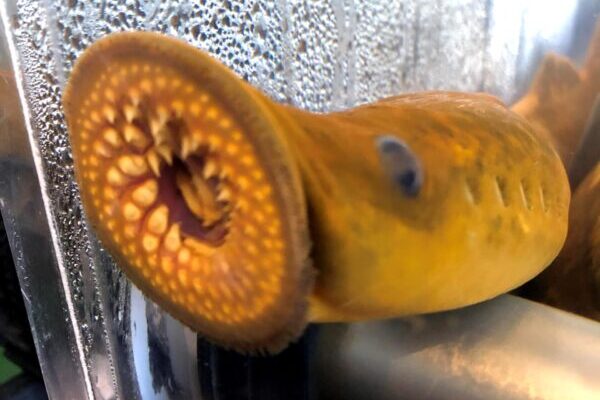Sea Lamprey

Species at a Glance
The sea lamprey (Petromyzon marinus) is a primitive, jawless fish that closely resembles an eel. It is an aggressive parasite that can have severe negative impacts on Great Lakes fish populations such as lake trout, rainbow trout, whitefish, and walleye. It uses its suction-cup like mouth and raspy teeth to latch on to its victims and feed on their blood and body fluids, killing or severely injuring native fish.
Species Description
Sea lampreys have long, flexible, cylindrical, scaleless bodies with a deeply notched dorsal fin, separating it into two distinct parts. The body is 30-51 cm (12-20 in) long and weight can range from 227-369 g (8-13 oz). Adults have a disc-like mouth that contains circular rows of over 100 sharp, hooked teeth. Larval lampreys, called ammocoetes, have a very small undeveloped mouth hidden between folds of skin. Juveniles have white undersides and uniformly colored blackish-blue or silver backs. Adults can be olive-brown, yellow-brown, green, red, or blue mottled with a darker shade of the same color; or sometimes nearly black. The underside is typically white or gray.
Native & Introduced Ranges
Native to the Atlantic Ocean, natural sea lamprey populations moved into freshwater areas of Lake Ontario and the St. Lawrence River to spawn. Now landlocked in the Great Lakes, the sea lamprey has distributed itself into the tributaries of those lakes. In Pennsylvania, sea lampreys are native to the Delaware and Susquehanna river basins in the eastern part of the state, and invasive in Lake Erie and Walnut Creek in Erie County.
Biology & Spread
The construction of the Welland Canal in 1921 provided a direct passageway for sea lamprey to swim from Lake Ontario to Lake Erie, bypassing Niagara Falls. It took just 25 years for populations to spread to the remaining Great Lakes.
Habitat
Sea lampreys require three distinctly different habitats connected by free-flowing stretches of stream. Spawning adults are found in late May or early June in shallow pits near the upper end of gravel riffles. After hatching, the larval lampreys, called ammocoetes, drift down to larger, slower moving streams and burrow into the sediment. After several years, they transform into parasitic adults and migrate into large bodies of water in the spring. They migrate back to tributary streams the following spring to spawn and then die shortly after.
Impacts
Threat to Biodiversity
Sea lampreys attach to other fish with their suction cup-like mouths and sharp teeth. A single sea lamprey can destroy up to 40 pounds of fish during its adult lifetime either directly by the loss of fluids and tissues, or indirectly from secondary infection of the wound. Sea lamprey are so destructive that under some conditions, only one out of seven fish attacked will survive. The sea lamprey population exploded in the 1940s and 1950s, contributing significantly to the collapse of economically important Great Lakes fish species such as lake trout, whitefish, burbot and walleye.
Prevention & Control
The primary method to control sea lamprey is the application of a lampricide called TFM to target sea lamprey larvae in their nursery tributaries. TFM kills the larval lamprey before they develop lethal mouths and migrate to the lakes to feed on fish, while most other organisms are left unaffected. Other control methods include erected barriers to prevent lampreys from gaining access to the tributary streams they need to spawn or using traps for physical removal. Sea lampreys have an extremely keen sense of smell, and since the 1990s the Great Lakes Fishery Commission and its research partners have been developing pheromones and alarm cues that could be used for sea lamprey control. These could be used to lure adults to traps, unsuitable spawning habitat, and areas that are easy and inexpensive to treat with lampricides, and repelling them from areas with productive spawning habitat and areas where control tactics are difficult or expensive to implement.
References:
Great Lakes Fishery Commission. Sea Lamprey Control in the Great Lakes: A Remarkable Success!
Pennsylvania Sea Grant. 2015. Pennsylvania’s Field Guide to Aquatic Invasive Species. Penn State Behrend



